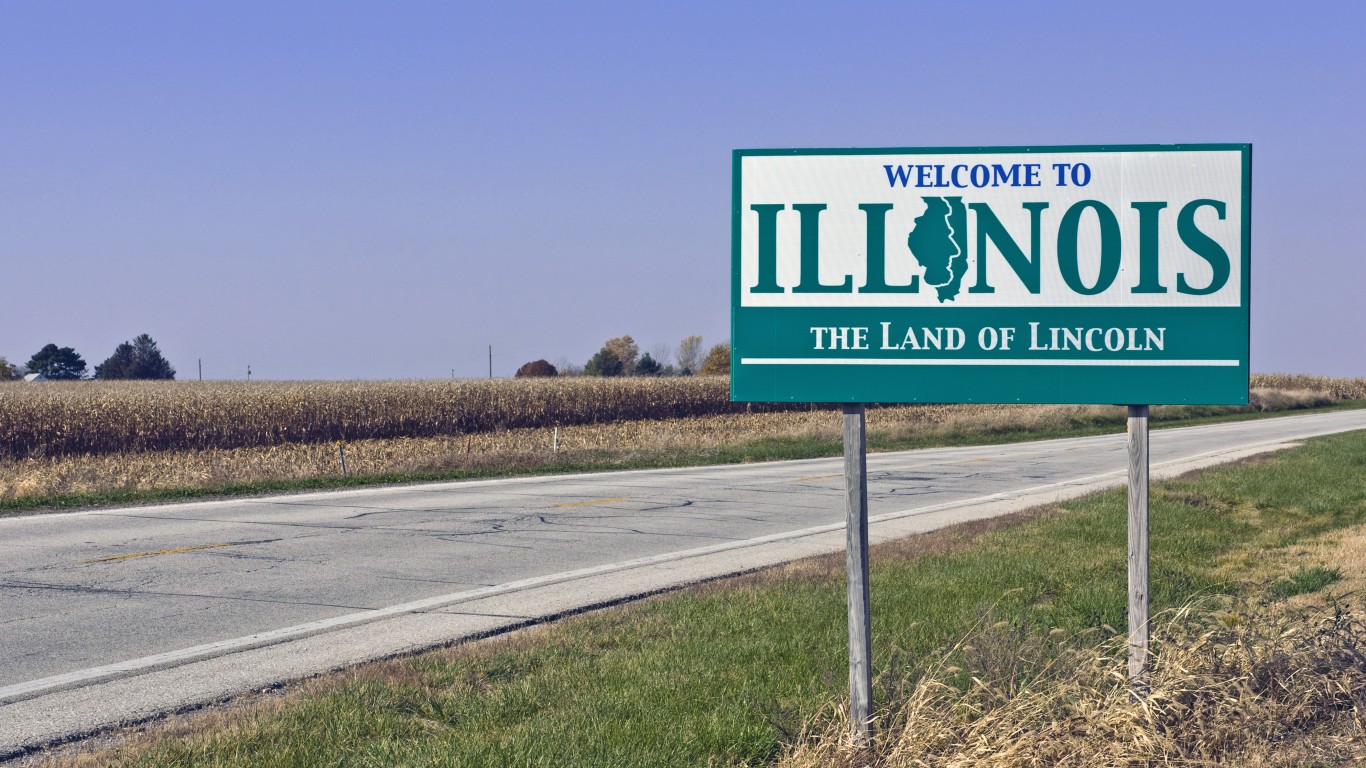

In 2015, state governments across the country spent a combined $605 billion on health care, or about $1,880 per resident.
The physical and mental well-being of the population is the single largest financial obligation of state governments, and comprises well over one-quarter of total state direct spending. As is the case with most expenditures, health spending varies at the state level dramatically, from just over $1,000 per capita to well over $3,000 per person.
The major categories of health spending at the state level include Medicaid coverage, state-run hospitals and medical schools, and finally other health expenses and programs addressing needs such as community wellness, substance abuse, health inspection, and pollution control.
Among these three categories, it is Medicaid spending that accounts for the largest portion of total state expenditure, at about 80% of annual state health costs. 24/7 Wall St. reviewed health spending in all 50 states, ranked from lowest total combined state health expenditure per capita to highest. This measure includes only direct state spending, which excludes local and federal spending.
Generally, states spent more if they had more expansive Medicaid eligibility and benefits. This was particularly the case for those states that opted to expand Medicaid coverage under the Affordable Care Act. Only one of the states spending the most per capita on health care, Mississippi, did not opt to expand Medicaid. Of the 20 states that spent the least on health care, 12 have not expanded Medicaid.
Those states with more poor, disabled, and elderly residents, also often spent more per capita. Disabled people and those over 65 are the ones who most commonly need health care and receive state Medicaid spending. In all, nearly 25% of Medicaid recipients are 65 or older, institutionalized, or disabled.
To identify what each state spends on retirement, 24/7 Wall St. reviewed the detailed health care expenditures by state governments as well as state revenue and cash / security holdings, provided by the U.S. Census Bureau’s 2015 State and Local Finance data. The share of the population over 65, in poverty, and with a disability all came from the U.S Census’ American Community Survey for 2016.
Click here to see what your state spends on health.

50. South Dakota
> 2015 state health spending: $1,022 per capita ($877 million)
> State government spending, all programs: $5,448 per capita (11th lowest)
> Population 65 and over: 15.9% (23rd highest)
> Population with a disability: 12.2% (19th lowest)
> Population with health insurance: 91.3% (21st lowest)
[in-text-ad]

49. Nebraska
> 2015 state health spending: $1,186 per capita ($2.2 billion)
> State government spending, all programs: $5,511 per capita (12th lowest)
> Population 65 and over: 14.9% (13th lowest)
> Population with a disability: 11.9% (16th lowest)
> Population with health insurance: 91.4% (22nd lowest)
[in-text-ad-2]

48. Georgia
> 2015 state health spending: $1,242 per capita ($12.7 billion)
> State government spending, all programs: $4,554 per capita (2nd lowest)
> Population 65 and over: 13.2% (4th lowest)
> Population with a disability: 12.9% (23rd lowest)
> Population with health insurance: 87.1% (4th lowest)

47. New Hampshire
> 2015 state health spending: $1,259 per capita ($1.7 billion)
> State government spending, all programs: $5,319 per capita (9th lowest)
> Population 65 and over: 17.0% (9th highest)
> Population with a disability: 12.8% (22nd lowest)
> Population with health insurance: 94.1% (15th highest)
[in-text-ad]

46. Nevada
> 2015 state health spending: $1,315 per capita ($3.8 billion)
> State government spending, all programs: $5,092 per capita (5th lowest)
> Population 65 and over: 14.9% (16th lowest)
> Population with a disability: 13.2% (25th highest)
> Population with health insurance: 88.6% (8th lowest)

45. Idaho
> 2015 state health spending: $1,345 per capita ($2.2 billion)
> State government spending, all programs: $5,361 per capita (10th lowest)
> Population 65 and over: 15.2% (21st lowest)
> Population with a disability: 13.5% (24th highest)
> Population with health insurance: 89.9% (11th lowest)

44. Montana
> 2015 state health spending: $1,381 per capita ($1.4 billion)
> State government spending, all programs: $7,210 per capita (19th highest)
> Population 65 and over: 17.6% (5th highest)
> Population with a disability: 14.4% (16th highest)
> Population with health insurance: 91.9% (24th lowest)
[in-text-ad-2]

43. North Carolina
> 2015 state health spending: $1,393 per capita ($14.0 billion)
> State government spending, all programs: $5,248 per capita (8th lowest)
> Population 65 and over: 15.4% (24th lowest)
> Population with a disability: 13.8% (20th highest)
> Population with health insurance: 89.6% (9th lowest)
[in-text-ad-2]

42. Florida
> 2015 state health spending: $1,403 per capita ($28.4 billion)
> State government spending, all programs: $4,256 per capita (the lowest)
> Population 65 and over: 19.8% (the highest)
> Population with a disability: 13.6% (22nd highest)
> Population with health insurance: 87.5% (5th lowest)

41. Texas
> 2015 state health spending: $1,409 per capita ($38.7 billion)
> State government spending, all programs: $4,985 per capita (4th lowest)
> Population 65 and over: 12.0% (3rd lowest)
> Population with a disability: 11.8% (15th lowest)
> Population with health insurance: 83.4% (the lowest)

40. Utah
> 2015 state health spending: $1,448 per capita ($4.3 billion)
> State government spending, all programs: $5,977 per capita (14th lowest)
> Population 65 and over: 10.5% (2nd lowest)
> Population with a disability: 9.9% (the lowest)
> Population with health insurance: 91.2% (18th lowest)
[in-text-ad]

39. Illinois
> 2015 state health spending: $1,482 per capita ($19.1 billion)
> State government spending, all programs: $6,400 per capita (21st lowest)
> Population 65 and over: 14.6% (9th lowest)
> Population with a disability: 11.0% (6th lowest)
> Population with health insurance: 93.5% (20th highest)
[in-text-ad-2]

38. Indiana
> 2015 state health spending: $1,491 per capita ($9.9 billion)
> State government spending, all programs: $5,663 per capita (13th lowest)
> Population 65 and over: 15.0% (17th lowest)
> Population with a disability: 13.9% (19th highest)
> Population with health insurance: 91.9% (24th lowest)

37. Tennessee
> 2015 state health spending: $1,498 per capita ($9.9 billion)
> State government spending, all programs: $4,739 per capita (3rd lowest)
> Population 65 and over: 15.6% (25th highest)
> Population with a disability: 15.5% (8th highest)
> Population with health insurance: 91.0% (16th lowest)
[in-text-ad-2]

36. Wyoming
> 2015 state health spending: $1,501 per capita ($890 million)
> State government spending, all programs: $10,930 per capita (2nd highest)
> Population 65 and over: 14.9% (16th lowest)
> Population with a disability: 13.6% (22nd highest)
> Population with health insurance: 88.5% (7th lowest)

35. Arizona
> 2015 state health spending: $1,598 per capita ($10.9 billion)
> State government spending, all programs: $5,175 per capita (6th lowest)
> Population 65 and over: 16.8% (12th highest)
> Population with a disability: 13.1% (25th lowest)
> Population with health insurance: 90.0% (13th lowest)

34. Virginia
> 2015 state health spending: $1,653 per capita ($13.9 billion)
> State government spending, all programs: $6,085 per capita (16th lowest)
> Population 65 and over: 14.6% (11th lowest)
> Population with a disability: 11.8% (15th lowest)
> Population with health insurance: 91.3% (21st lowest)

33. Oklahoma
> 2015 state health spending: $1,655 per capita ($6.5 billion)
> State government spending, all programs: $6,132 per capita (17th lowest)
> Population 65 and over: 14.9% (16th lowest)
> Population with a disability: 16.1% (6th highest)
> Population with health insurance: 86.2% (3rd lowest)

32. Alabama
> 2015 state health spending: $1,679 per capita ($8.2 billion)
> State government spending, all programs: $6,007 per capita (15th lowest)
> Population 65 and over: 16.1% (19th highest)
> Population with a disability: 16.5% (4th highest)
> Population with health insurance: 90.9% (15th lowest)
[in-text-ad-2]

31. North Dakota
> 2015 state health spending: $1,690 per capita ($1.3 billion)
> State government spending, all programs: $10,864 per capita (3rd highest)
> Population 65 and over: 14.5% (8th lowest)
> Population with a disability: 11.5% (11th lowest)
> Population with health insurance: 93.0% (21st highest)
[in-text-ad-2]

30. Michigan
> 2015 state health spending: $1,743 per capita ($17.3 billion)
> State government spending, all programs: $6,819 per capita (25th lowest)
> Population 65 and over: 16.2% (18th highest)
> Population with a disability: 14.5% (15th highest)
> Population with health insurance: 94.6% (11th highest)

29. Colorado
> 2015 state health spending: $1,758 per capita ($9.6 billion)
> State government spending, all programs: $6,311 per capita (20th lowest)
> Population 65 and over: 13.3% (5th lowest)
> Population with a disability: 10.6% (3rd lowest)
> Population with health insurance: 92.5% (23rd highest)

28. Kansas
> 2015 state health spending: $1,760 per capita ($5.1 billion)
> State government spending, all programs: $6,158 per capita (18th lowest)
> Population 65 and over: 15.1% (20th lowest)
> Population with a disability: 12.8% (22nd lowest)
> Population with health insurance: 91.3% (21st lowest)

27. Louisiana
> 2015 state health spending: $1,815 per capita ($8.5 billion)
> State government spending, all programs: $6,634 per capita (22nd lowest)
> Population 65 and over: 14.4% (7th lowest)
> Population with a disability: 15.5% (8th highest)
> Population with health insurance: 89.7% (10th lowest)

26. Ohio
> 2015 state health spending: $1,820 per capita ($21.1 billion)
> State government spending, all programs: $6,804 per capita (24th lowest)
> Population 65 and over: 16.3% (16th highest)
> Population with a disability: 14.2% (17th highest)
> Population with health insurance: 94.4% (12th highest)

25. Missouri
> 2015 state health spending: $1,837 per capita ($11.2 billion)
> State government spending, all programs: $5,223 per capita (7th lowest)
> Population 65 and over: 16.0% (22nd highest)
> Population with a disability: 14.6% (13th highest)
> Population with health insurance: 91.1% (17th lowest)
[in-text-ad-2]

24. Wisconsin
> 2015 state health spending: $1,845 per capita ($10.6 billion)
> State government spending, all programs: $6,892 per capita (25th highest)
> Population 65 and over: 16.1% (19th highest)
> Population with a disability: 12.0% (17th lowest)
> Population with health insurance: 94.7% (9th highest)
[in-text-ad]

23. South Carolina
> 2015 state health spending: $1,879 per capita ($9.2 billion)
> State government spending, all programs: $6,242 per capita (19th lowest)
> Population 65 and over: 16.8% (11th highest)
> Population with a disability: 15.2% (10th highest)
> Population with health insurance: 90.0% (13th lowest)
[in-text-ad]

22. Maryland
> 2015 state health spending: $1,899 per capita ($11.4 billion)
> State government spending, all programs: $7,190 per capita (20th highest)
> Population 65 and over: 14.6% (11th lowest)
> Population with a disability: 11.1% (7th lowest)
> Population with health insurance: 93.9% (17th highest)

21. New Jersey
> 2015 state health spending: $1,927 per capita ($17.3 billion)
> State government spending, all programs: $7,974 per capita (13th highest)
> Population 65 and over: 15.4% (23rd lowest)
> Population with a disability: 10.5% (2nd lowest)
> Population with health insurance: 92.0% (25th highest)

20. Pennsylvania
> 2015 state health spending: $1,950 per capita ($25.0 billion)
> State government spending, all programs: $6,947 per capita (24th highest)
> Population 65 and over: 17.4% (7th highest)
> Population with a disability: 14.2% (17th highest)
> Population with health insurance: 94.4% (12th highest)
[in-text-ad]

19. Washington
> 2015 state health spending: $1,963 per capita ($14.1 billion)
> State government spending, all programs: $7,094 per capita (22nd highest)
> Population 65 and over: 14.8% (12th lowest)
> Population with a disability: 13.0% (24th lowest)
> Population with health insurance: 94.0% (16th highest)

18. Minnesota
> 2015 state health spending: $2,032 per capita ($11.2 billion)
> State government spending, all programs: $7,876 per capita (15th highest)
> Population 65 and over: 15.1% (19th lowest)
> Population with a disability: 11.0% (6th lowest)
> Population with health insurance: 95.9% (4th highest)

17. Maine
> 2015 state health spending: $2,106 per capita ($2.8 billion)
> State government spending, all programs: $6,651 per capita (23rd lowest)
> Population 65 and over: 19.2% (2nd highest)
> Population with a disability: 15.8% (7th highest)
> Population with health insurance: 92.0% (25th highest)

16. West Virginia
> 2015 state health spending: $2,222 per capita ($4.1 billion)
> State government spending, all programs: $7,315 per capita (17th highest)
> Population 65 and over: 18.7% (3rd highest)
> Population with a disability: 20.1% (the highest)
> Population with health insurance: 94.7% (9th highest)
[in-text-ad]

15. Connecticut
> 2015 state health spending: $2,235 per capita ($8.0 billion)
> State government spending, all programs: $8,603 per capita (10th highest)
> Population 65 and over: 16.1% (19th highest)
> Population with a disability: 11.2% (8th lowest)
> Population with health insurance: 95.1% (7th highest)

14. Alaska
> 2015 state health spending: $2,285 per capita ($1.7 billion)
> State government spending, all programs: $17,614 per capita (the highest)
> Population 65 and over: 10.3% (the lowest)
> Population with a disability: 12.1% (18th lowest)
> Population with health insurance: 86.0% (2nd lowest)

13. Rhode Island
> 2015 state health spending: $2,285 per capita ($2.4 billion)
> State government spending, all programs: $8,121 per capita (12th highest)
> Population 65 and over: 16.4% (14th highest)
> Population with a disability: 13.8% (20th highest)
> Population with health insurance: 95.7% (5th highest)

12. Mississippi
> 2015 state health spending: $2,297 per capita ($6.9 billion)
> State government spending, all programs: $7,055 per capita (23rd highest)
> Population 65 and over: 15.0% (18th lowest)
> Population with a disability: 16.3% (5th highest)
> Population with health insurance: 88.2% (6th lowest)

11. Iowa
> 2015 state health spending: $2,320 per capita ($7.2 billion)
> State government spending, all programs: $7,287 per capita (18th highest)
> Population 65 and over: 16.4% (14th highest)
> Population with a disability: 11.8% (15th lowest)
> Population with health insurance: 95.7% (5th highest)
[in-text-ad]

10. Hawaii
> 2015 state health spending: $2,343 per capita ($3.4 billion)
> State government spending, all programs: $8,672 per capita (9th highest)
> Population 65 and over: 17.1% (8th highest)
> Population with a disability: 11.3% (9th lowest)
> Population with health insurance: 96.5% (2nd highest)

9. California
> 2015 state health spending: $2,343 per capita ($91.7 billion)
> State government spending, all programs: $8,190 per capita (11th highest)
> Population 65 and over: 13.5% (6th lowest)
> Population with a disability: 10.9% (4th lowest)
> Population with health insurance: 92.7% (22nd highest)

8. Arkansas
> 2015 state health spending: $2,441 per capita ($7.3 billion)
> State government spending, all programs: $7,175 per capita (21st highest)
> Population 65 and over: 16.3% (16th highest)
> Population with a disability: 17.0% (3rd highest)
> Population with health insurance: 92.1% (24th highest)

7. Delaware
> 2015 state health spending: $2,536 per capita ($2.4 billion)
> State government spending, all programs: $9,509 per capita (6th highest)
> Population 65 and over: 17.6% (5th highest)
> Population with a disability: 12.3% (20th lowest)
> Population with health insurance: 94.3% (14th highest)

6. Oregon
> 2015 state health spending: $2,538 per capita ($10.2 billion)
> State government spending, all programs: $7,958 per capita (14th highest)
> Population 65 and over: 16.9% (10th highest)
> Population with a disability: 14.7% (12th highest)
> Population with health insurance: 93.8% (19th highest)

5. Massachusetts
> 2015 state health spending: $2,596 per capita ($17.6 billion)
> State government spending, all programs: $9,034 per capita (8th highest)
> Population 65 and over: 15.8% (24th highest)
> Population with a disability: 11.7% (12th lowest)
> Population with health insurance: 97.5% (the highest)

4. Vermont
> 2015 state health spending: $2,605 per capita ($1.6 billion)
> State government spending, all programs: $10,311 per capita (4th highest)
> Population 65 and over: 18.2% (4th highest)
> Population with a disability: 14.6% (13th highest)
> Population with health insurance: 96.3% (3rd highest)

3. Kentucky
> 2015 state health spending: $2,618 per capita ($11.6 billion)
> State government spending, all programs: $7,530 per capita (16th highest)
> Population 65 and over: 15.6% (25th lowest)
> Population with a disability: 17.9% (2nd highest)
> Population with health insurance: 94.9% (8th highest)

2. New York
> 2015 state health spending: $2,911 per capita ($57.6 billion)
> State government spending, all programs: $9,376 per capita (7th highest)
> Population 65 and over: 15.3% (22nd lowest)
> Population with a disability: 11.5% (11th lowest)
> Population with health insurance: 93.9% (17th highest)
[in-text-ad-2]

1. New Mexico
> 2015 state health spending: $3,225 per capita ($6.7 billion)
> State government spending, all programs: $9,613 per capita (5th highest)
> Population 65 and over: 16.5% (13th highest)
> Population with a disability: 15.1% (11th highest)
> Population with health insurance: 90.8% (14th lowest)
Take This Retirement Quiz To Get Matched With An Advisor Now (Sponsored)
Are you ready for retirement? Planning for retirement can be overwhelming, that’s why it could be a good idea to speak to a fiduciary financial advisor about your goals today.
Start by taking this retirement quiz right here from SmartAsset that will match you with up to 3 financial advisors that serve your area and beyond in 5 minutes. Smart Asset is now matching over 50,000 people a month.
Click here now to get started.
Thank you for reading! Have some feedback for us?
Contact the 24/7 Wall St. editorial team.
 24/7 Wall St.
24/7 Wall St.
